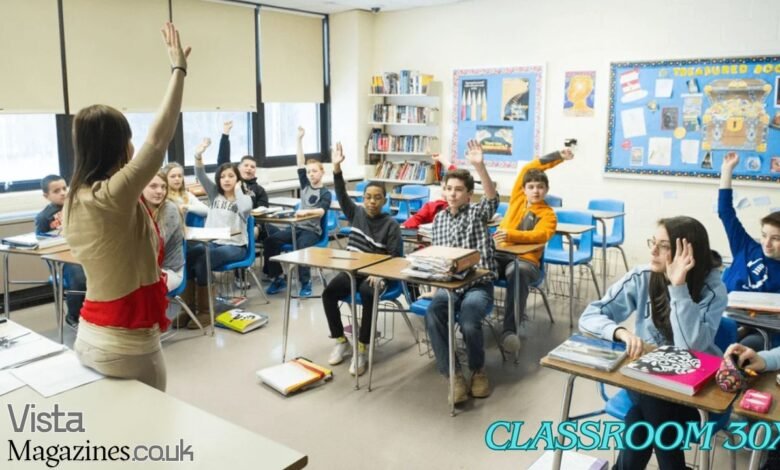Classroom 30x: Redefining the Future of Education

Introduction: The Evolution of Learning Through Classroom 30x
In today’s world of rapid technological advancement, the education system is constantly transforming to meet the needs of modern learners. One of the most innovative developments in this evolution is Classroom 30x, a next-generation learning framework designed to merge technology, collaboration, and creativity in one dynamic educational ecosystem.
Classroom 30x is more than just a physical or digital space—it represents a holistic approach to learning that focuses on interactivity, adaptability, and engagement. From smart classrooms to AI-driven instruction, Classroom 30x is setting the foundation for the schools of the future.
What Is Classroom 30x?
Classroom 30x is a conceptual and technological model that integrates advanced learning tools, digital connectivity, and collaborative environments into the educational experience. It’s not a single product but a comprehensive system designed to enhance how teachers teach and students learn.
The term Classroom 30x symbolizes progress—an evolution from traditional classrooms (1.0), through digital classrooms (2.0), to fully integrated intelligent learning spaces (3.0 and beyond).

The Core Philosophy of Classroom 30x
The philosophy behind Classroom 30x revolves around three main principles: personalization, collaboration, and innovation. Education is no longer about one-size-fits-all lectures. Instead, Classroom 30x empowers learners to take ownership of their education through technology-enabled engagement.
By focusing on student-centered learning, Classroom 30x aligns with modern pedagogical theories that prioritize exploration, creativity, and problem-solving over rote memorization.
Technology Integration in Classroom 30x
At the heart of Classroom 30x lies technology. Artificial intelligence, virtual reality (VR), and augmented reality (AR) are seamlessly woven into lessons to create immersive educational experiences.
Smartboards, interactive tablets, cloud collaboration tools, and real-time analytics systems are standard components of Classroom 30x. These tools not only enhance engagement but also provide educators with valuable insights into student performance.
AI and Personalized Learning
Artificial intelligence plays a central role in Classroom 30x. Through AI-powered algorithms, learning can be tailored to each student’s unique needs, pace, and abilities.
For example, Classroom 30x can identify areas where a student struggles and suggest supplementary material automatically. This ensures that every learner receives the right level of challenge and support, fostering better academic outcomes.
Collaborative Learning Environments
One defining feature of Classroom 30x is its emphasis on collaboration. Group work is facilitated by digital tools that allow students to share, discuss, and co-create projects both in-person and remotely.
Collaboration in Classroom 30x extends beyond classmates—it includes educators, industry experts, and global peers, creating an interconnected network of knowledge exchange.
Gamification and Engagement
Gamification is a key strategy in Classroom 30x, using interactive learning experiences to boost motivation and retention. Points, badges, and progress tracking make learning feel like an adventure rather than a chore.
By turning lessons into engaging challenges, Classroom 30x helps students develop resilience, strategic thinking, and a passion for discovery.
Data Analytics and Feedback Systems

Another major advancement within Classroom 30x is data-driven education. Every student interaction, assignment, and assessment generates useful insights.
These data points are analyzed to help teachers adjust instruction in real time, ensuring that Classroom 30x remains adaptive to evolving classroom needs.
The Role of Teachers in Classroom 30x
In the Classroom 30x model, teachers are facilitators rather than mere lecturers. They guide students in navigating resources, exploring concepts, and applying knowledge creatively.
This shift allows educators to focus on mentorship, emotional intelligence, and personalized feedback—key factors that define the Classroom 30x approach.
Student Empowerment and Autonomy
Classroom 30x empowers students to take control of their learning. Through self-paced modules and interactive resources, learners become active participants in their education.
This autonomy encourages accountability, critical thinking, and lifelong learning—all essential skills for the modern world.
Hybrid and Remote Learning Integration
The pandemic accelerated the adoption of digital education, and Classroom 30x builds upon that foundation by seamlessly integrating hybrid learning models.
Whether students are in a physical classroom or learning remotely, Classroom 30x ensures consistent access to resources, real-time communication, and immersive experiences through advanced digital platforms.
Accessibility and Inclusivity
Accessibility is a cornerstone of Classroom 30x. The framework is designed to be inclusive of students with diverse learning needs and abilities.
From voice-assisted tools to adaptive interfaces, Classroom 30x leverages technology to ensure that no learner is left behind. Inclusivity is embedded in its very design philosophy.
Sustainability and Green Education
In addition to educational innovation, Classroom 30x incorporates sustainability. Digital tools reduce paper use, and energy-efficient technologies support eco-friendly operations.
The Classroom 30x model encourages students to learn about environmental responsibility through experiential projects and community-driven sustainability programs.
Security and Privacy in Classroom 30x
As technology becomes more integrated into learning, protecting data privacy and security is vital. Classroom 30x prioritizes encryption, secure cloud storage, and user consent in all digital interactions.
Educators and developers working on Classroom 30x adhere to ethical technology standards to ensure a safe, transparent learning environment.
Global Collaboration Through Classroom 30x
Classroom 30x fosters global education by connecting classrooms worldwide. Through cloud-based systems, students can collaborate on projects with peers in different countries, promoting cross-cultural understanding.
This international aspect of Classroom 30x helps cultivate global citizenship, empathy, and a deeper appreciation of diversity.
The Benefits of Classroom 30x
Key benefits of Classroom 30x include:
- Personalized and adaptive learning experiences.
- Increased student engagement and motivation.
- Real-time feedback and progress tracking.
- Global connectivity and cultural exchange.
- Inclusive education for all learners.
These advantages make Classroom 30x a transformative force in 21st-century education.
Challenges and Future Outlook
While promising, Classroom 30x faces challenges such as technological disparities, infrastructure limitations, and digital literacy gaps. Ensuring equitable access will be crucial as education becomes more reliant on digital systems.
The future of Classroom 30x depends on collaboration between educators, policymakers, and technologists to make advanced learning environments accessible to all.
How Schools Can Adopt Classroom 30x
Transitioning to Classroom 30x involves gradual integration of digital tools, teacher training, and infrastructure development. Schools can start by introducing smart classrooms, cloud-based learning platforms, and professional development for educators.
Over time, adopting the Classroom 30x philosophy fosters innovation and prepares institutions for the evolving educational landscape.
Conclusion: Shaping Tomorrow’s Learning Experience
Classroom 30x represents the future of education—a harmonious blend of technology, creativity, and human connection. It challenges traditional learning models and redefines what it means to be a student or teacher in the modern era.
By embracing Classroom 30x, educators can unlock limitless possibilities for interactive, inclusive, and personalized learning. As the world continues to evolve, Classroom 30x stands as a beacon of progress, guiding education into a smarter, more connected future.
Also Read: Hormita: Understanding Its Meaning, Origins, and Modern Significance


